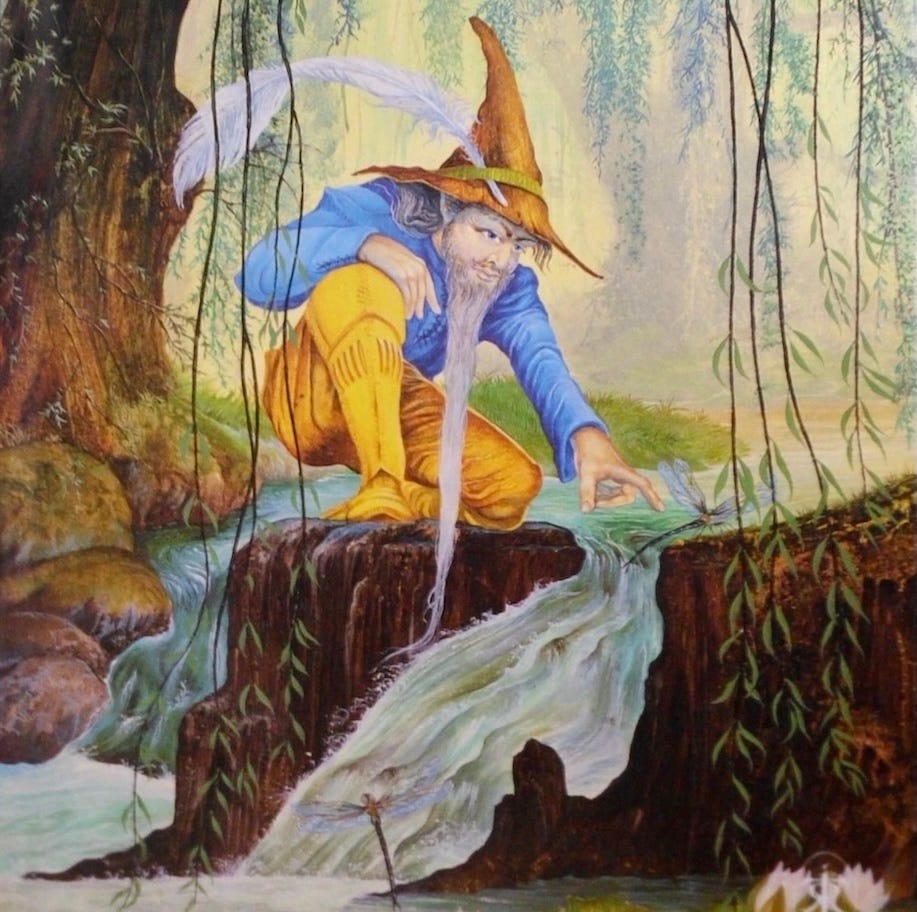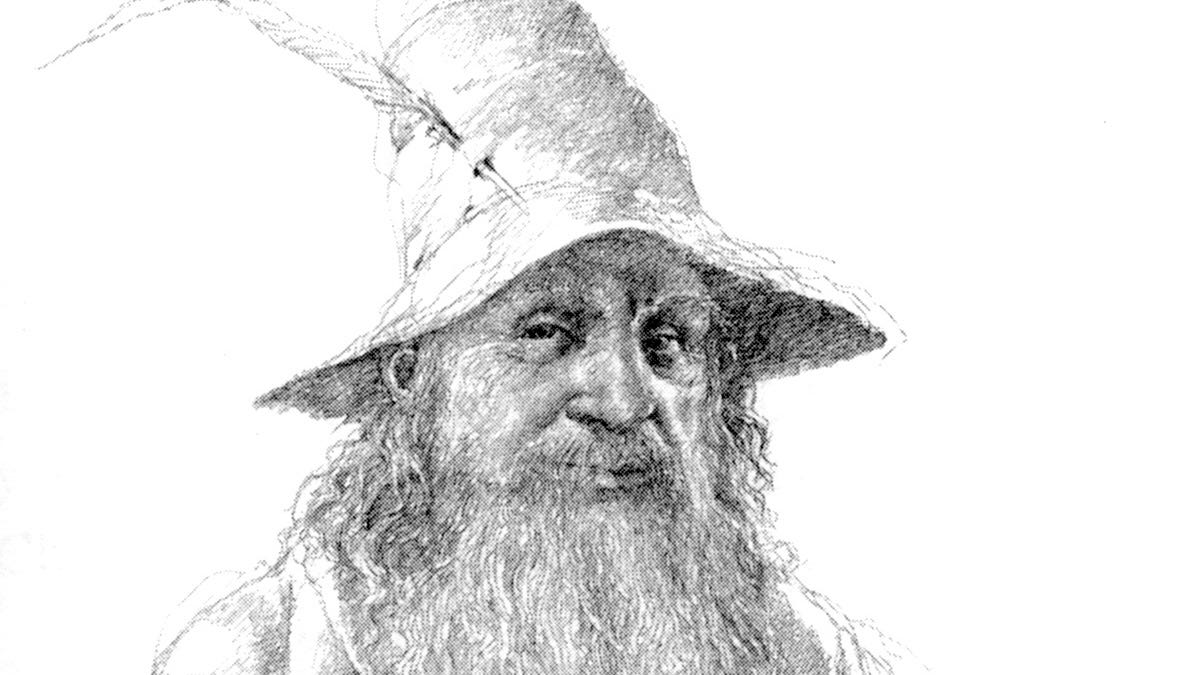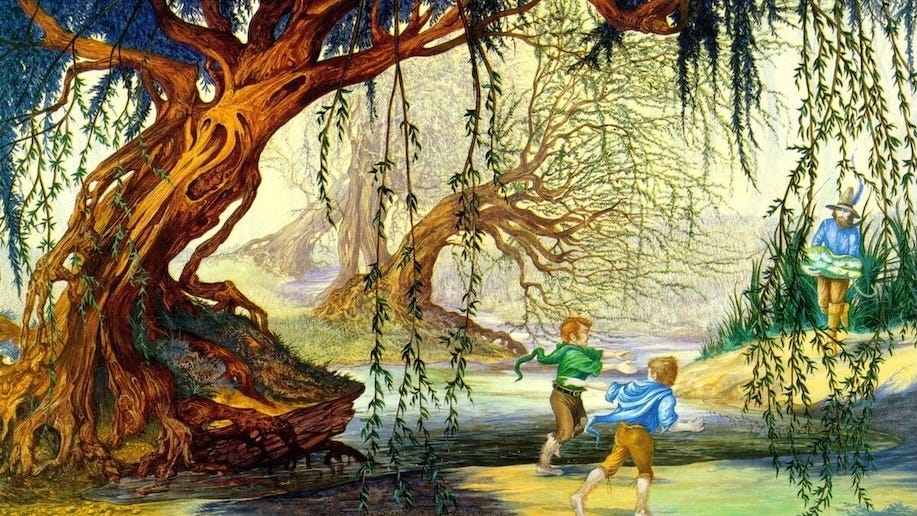The Unsung Hero of The Lord of the Rings
Tolkien's secret to resisting evil
Even in a mythical age there must be some enigmas, as there always are. Tom Bombadil is one (intentionally).
-J.R.R. Tolkien
Tom Bombadil is one of the greatest characters in the entire Lord of the Rings trilogy. He is the oldest being in Middle-earth, completely immune to the Ring’s power, and — unfortunately — overlooked by a huge swathe of readers.
“Readers” is indeed the right word to use here, since Tom Bombadil is so confounding that Peter Jackson cut him out of the films entirely: if you’ve never read the books, you’ve likely never heard of him. But despite the enigma that he is, Bombadil plays an incredibly important role in deciphering the world of Tolkien’s Middle-earth.
Today, we explore what the mysterious character of Tom Bombadil reveals not only about the world Tolkien created, but about the author’s own worldview as well. For in the words of Tolkien himself, Bombadil “represents something that I feel [is] important” — which is an understatement if there ever were one.
So what does Bombadil represent about the underlying ethics of Middle-earth and the key to overcoming evil? Keep reading to find out…
Reminder: this is a teaser of our members-only deep dives.
To support our mission and get exclusive content every single week, upgrade for a few dollars per month. You’ll get:
Full-length articles 2x per week
The entire archive of premium articles and podcasts
Membership to our bi-weekly book club (+ subscriber chat room)!
Our paid subscriber Great Books Club is currently reading Milton’s Paradise Lost. The next meeting is on Wednesday October 8, at noon ET — join us!
A Merry Fellow
Old Tom Bombadil was a merry fellow;
bright blue his jacket was and his boots were yellow,
green were his girdle and his breeches all of leather;
he wore in his tall hat a swan-wing feather.
-J.R.R. Tolkien, The Adventures of Tom Bombadil
Tom Bombadil precedes the publication of The Lord of the Rings by over three decades, and the writing of it by nearly two. In a poetic turn of events that surely must have been a delight to Tolkien himself, the inspiration for Middle-earth’s most extraordinary character came from a Dutch doll belonging to Tolkien’s children — and which was eventually flushed down the toilet.
Tolkien originally imagined the doll Bombadil as a sort of nature spirit of the English countryside, and began composing brief, lighthearted rhymes about him. In many ways, he was a precursor to The Lord of the Rings, and this was reflected in the names that the different peoples of Middle-earth gave to Bombadil himself.
In the tongue of the Dúnedain men, for example, Bombadil is called Iarwain Ben-Adar: “oldest and fatherless”. The Rohirrim call him Orald (“very ancient”), and the dwarves call him Forn (“belonging to ancient days”). These names reflect not just the creation of Bombadil as a character, but also his unique role in Middle-earth — suggesting that he is, in fact, the oldest created being.
In The Fellowship of the Ring, when considering Sauron’s potential victory over Middle-earth, the elf Glofindel states:
...in the end, if all else is conquered, Bombadil will fall, Last as he was First; and then Night will come.
Clearly, Tom Bombadil is a figure of significant importance in Middle-earth. So what happens when he finally meets the hobbits, and what does their encounter reveal about what he represents?
“He Is”
Readers of The Lord of the Rings first meet Tom Bombadil early on in the hobbits’ quest, before they reach Bree and the Prancing Pony Inn. He first appears to rescue Merry and Pippin from the clutches of Old Man Willow, and then invites the hobbits to stay at his house in the Old Forest.
While at Tom’s house, the hobbits’ experience becomes increasingly fantastical. At night, for example, Frodo has dreams that feel more like visions — in one of them, he sees a man being carried away from a tower on an eagle, who we later learn was Gandalf escaping from Isengard. Then when the hobbits go on an excursion, they get attacked by a barrow-wight, and saved by Bombadil once more.
Back at Tom’s house, the hobbits realize the ring has no power over Bombadil. He can see Frodo (who is invisible to everyone else) when he wears the One Ring, and when Tom himself dons it, he remains visible. He treats the ring as a plaything, making it disappear with a magic trick before Frodo’s eyes.
So what about Tom makes it so that he isn’t impacted by the ring? Part of the answer might be found in what his wife Goldberry says about him. When Frodo asks her exactly who Tom is, she simply replies “He is.” It’s a cryptic answer that echoes God’s famous answer to Moses in the Book of Exodus: “I am who I am.”
But does this mean Bombadil is a god? Although that’s a popular theory, Tolkien himself refuted it in a letter. Writing to his editor, he explained the hidden meaning of Tom Bombadil.
Remember, the Ring is often read as a stand-in for vice and the temptation to power, and Tom Bombadil has a remarkable ability to resist it unlike any other.
And that’s where Tolkien’s letter, as well as a closer inspection of the text, reveals a crucial moral message underlying all of The Lord of the Rings — and the key to resisting evil yourself...
Keep reading with a 7-day free trial
Subscribe to The Culturist to keep reading this post and get 7 days of free access to the full post archives.







